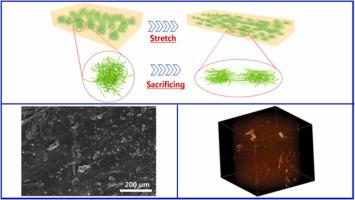Industrial Crops and Products ( IF 5.9 ) Pub Date : 2022-06-16 , DOI: 10.1016/j.indcrop.2022.115227 Bin Sun , Ziting Yuan , Kai Li , Wei Tang , Juan Xu , Han Zheng , Geng Li , Yuxin Liu

|
Double-network reinforcement strategy has been widely used to improve hydrogels' toughness but is rarely applied in bulk polymer. The key to this strategy is introducing sacrificial bonds to improve strength and maintain the integrity of the polymer matrix at high elongation, dissipating applied energy as much as possible. In this study, a micron-sized microgel was employed as a sacrificial agent to reinforce polymer matrix. A simple and versatile process was introduced for the fabrication of cellulose microgel/ poly(butyl acrylate(BA)-co-methyl methacrylate(MMA)) nanocomposites by in situ free-radical polymerizations of BA and MMA complex monomer solution contained with well-dispersed cellulose microgels. After polymerization, the microgels were found homogeneously distributed within the polymer matrix. The organic-phase bacterial cellulose microgels (OB-microgel) reinforced polymer exhibited marvelous performance in the tensile test. The ultimate strength, Young's modulus, and toughness of P(BA-co-MMA) reinforced with 1.0 wt% OB-microgel were 1.13 MPa, 1.09 MPa, and 1.11 KJ m−3, about 2–3 times higher than neat P(BA-co-MMA) respectively. Moreover, a high strain to failure similar to the neat P(BA-co-MMA) was maintained. This reinforcement was mainly attributed to the sacrificing effect of microgel, not the formation of a percolation network, which was also supported by DMA test. Hence, cellulose microgel consisting of cellulose nanofiber network was demonstrated to be an efficient energy dissipation agent for the continuous phase of the polymer matrix to acquire high strain to failure and high tensile strength.
中文翻译:

用纤维素微凝胶显着增强弹性体的韧性:采用聚合物基体和纤维素纳米纤维网络作为连续相和能量耗散剂
双网络增强策略已被广泛用于提高水凝胶的韧性,但很少应用于本体聚合物。该策略的关键是引入牺牲键以提高强度并在高伸长率下保持聚合物基体的完整性,尽可能耗散施加的能量。在这项研究中,使用微米级微凝胶作为牺牲剂来增强聚合物基质。介绍了一种简单而通用的原位制备纤维素微凝胶/聚(丙烯酸丁酯(BA)-共-甲基丙烯酸甲酯(MMA))纳米复合材料的工艺。含有分散良好的纤维素微凝胶的 BA 和 MMA 复合单体溶液的自由基聚合。聚合后,发现微凝胶均匀分布在聚合物基质中。有机相细菌纤维素微凝胶(OB-microgel)增强聚合物在拉伸试验中表现出惊人的性能。1.0 wt% OB-微凝胶增强的P(BA-co-MMA)的极限强度、杨氏模量和韧性分别为1.13 MPa、1.09 MPa和1.11 KJ m -3,分别比纯 P(BA-co-MMA) 高约 2-3 倍。此外,保持了与纯 P(BA-co-MMA) 相似的高应变失效。这种增强主要归因于微凝胶的牺牲效应,而不是渗透网络的形成,这也得到了 DMA 测试的支持。因此,由纤维素纳米纤维网络组成的纤维素微凝胶被证明是一种有效的能量耗散剂,用于聚合物基质的连续相,以获得高应变失效和高拉伸强度。



























 京公网安备 11010802027423号
京公网安备 11010802027423号